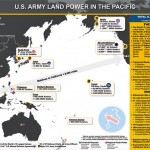Leading Across 16 Time Zones
Driving onto Palm Circle at Fort Shafter is like driving through a time warp. Suddenly you are back in Hawaii’s elegant “military” era of the 1940s, with barracks and residences right out of the classic From Here to Eternity – a setting befitting the physical headquarters of the commanding general of all U.S. Army Forces in the Pacific (USARPAC).
Arriving a little early for my interview with Lt. Gen. Francis “Frank” Wiercinski (one tends to do that when one’s appointment is with a three-star general), I was waiting in the comfort of the VIP anteroom, the glass-case repository of the general’s gifts from his counterparts in Pacific rim allied countries. The traditional gifts are from command to command, so they never rotate with individual commanders. My favorite in the USARPAC collection was an elegant miniature silver filigree coach with horses and coachmen from an armed forces commander in India.
- Lt. Gen. Francis ‘Frank’ Wiercinski addresses the press corps at the Pentagon. U.S. Army photo
- The Army covers a lot of ground — and sea — in the Pacific region | Image courtesy U.S. Army
The general is a big guy with shoulders broad enough to carry the U.S. Army’s responsibilities that go with a 9,000-mile stretch across the Pacific, crossing 16 time zones, from California to the Maldives, or as the general puts it, “From Hollywood to Bollywood” (in Mumbai, India’s moviemaking center).
Also consider: The area includes the world’s three largest economies (U.S., China, Japan), the world’s four largest populations (China, Indonesia, U.S., India), six of the world’s 10 largest armies (China, India, Vietnam, North Korea, South Korea, U.S.), and five of America’s seven mutual-defense pacts (Japan, Philippines, South Korea, Thailand, Australia) – not to mention the 86,000 U.S. Army personnel who go with it.
As it happens, Wiercinski’s major focus in his 34-year career has been the Pacific, starting as a lieutenant platoon leader in Schofield’s 25th Infantry Division, and ending with his July retirement as the commanding general of the U.S. Army-Pacific. Significantly, the Army’s Pacific responsibilities have grown so much during his tenure, this three-star general will be replaced by a four-star (the nomination process is under way).
Even though much about the general’s command deals with classified information and politically sensitive issues, he was comfortable addressing a wide range of subjects, starting with the recent saber-rattling by North Korea’s new firebrand leader Kim Jong-Un. Although the North’s ICBM testing has been spotty at best, after Guam, Hawaii also could be on Kim’s short target wish list.
But Wiercinski points out that our Pacific version of SDI (Strategic Defense Initiative), which consists of various ship-based anti-ICBM weapons and the powerful “S band” early warning radar (the huge, white radome mounted on a converted oil drilling rig we see based at Pearl Harbor but deployable to the Northern Pacific – which it was very recently), has been augmented by a new layer of strategic defense. It’s called THAAD (Thermal High Altitude Area Defense), which recently has completed successful testing and is now on Guam. Hawaii residents can sleep soundly at night with the knowledge that the best missile defensive system in the world is in place and at the ready.
As for our eventual withdrawal from South Korea, strategic planning for that desired outcome has been ongoing from the time we first entered Korea in the 1950s. But it remains dependent upon the ever-evolving leadership picture in North Korea, and the political and military dynamics of other theater players such as South Korea, China and Japan.
Wiercinski and I discussed the Air Force’s recent sexual harassment scandal, in which one of the actual anti-harassment instructors has been charged with sexual harassment, and the issue in the military in general. He expressed pride that he has replaced dozens of pages of “command guidance” with two short axioms: “Always treat everyone with dignity and respect” and “Do the right thing.”
Wiercinski lauds Hawaii, its leaders and its people for warmly embracing the military and its mission. The lone exception is the ongoing controversy over access to the ideal training areas in Makua Valley and Pohakuloa on the Big Island. (The higher slopes of Pohakuloa, for example, are ideal for training Army helicopter pilots for conditions in Afghanistan): “I refuse to send Hawaii’s sons and daughters into combat untrained.”
Despite the Army being “the most conscientious steward of the environment and cultural aspects of these areas,” legal challenges have made it necessary to send troops to Mainland training areas at great expense, and worse, causing more family separations than necessary. And with the ever-increasing military emphasis on the Pacific, training requirements will continue to increase.
The general discussed a wide range of other issues: Women in combat (no lower physical standards), Army suicide rates (serious issue, but still lower than civilian rate), post-combat reintegration (“We always return from combat a changed person.”), quality of recruits (only accept the top one-third of applicants; biggest disqualifier: physical condition) – all great subjects for future columns.
The Wiercinski family loves Hawaii, and the general is hoping to stay after his retirement. Any local corporation or business entity could find no individual more capable of handling responsibility and leadership.
MidWeek wishes you well, General, and the warmest possible aloha.





